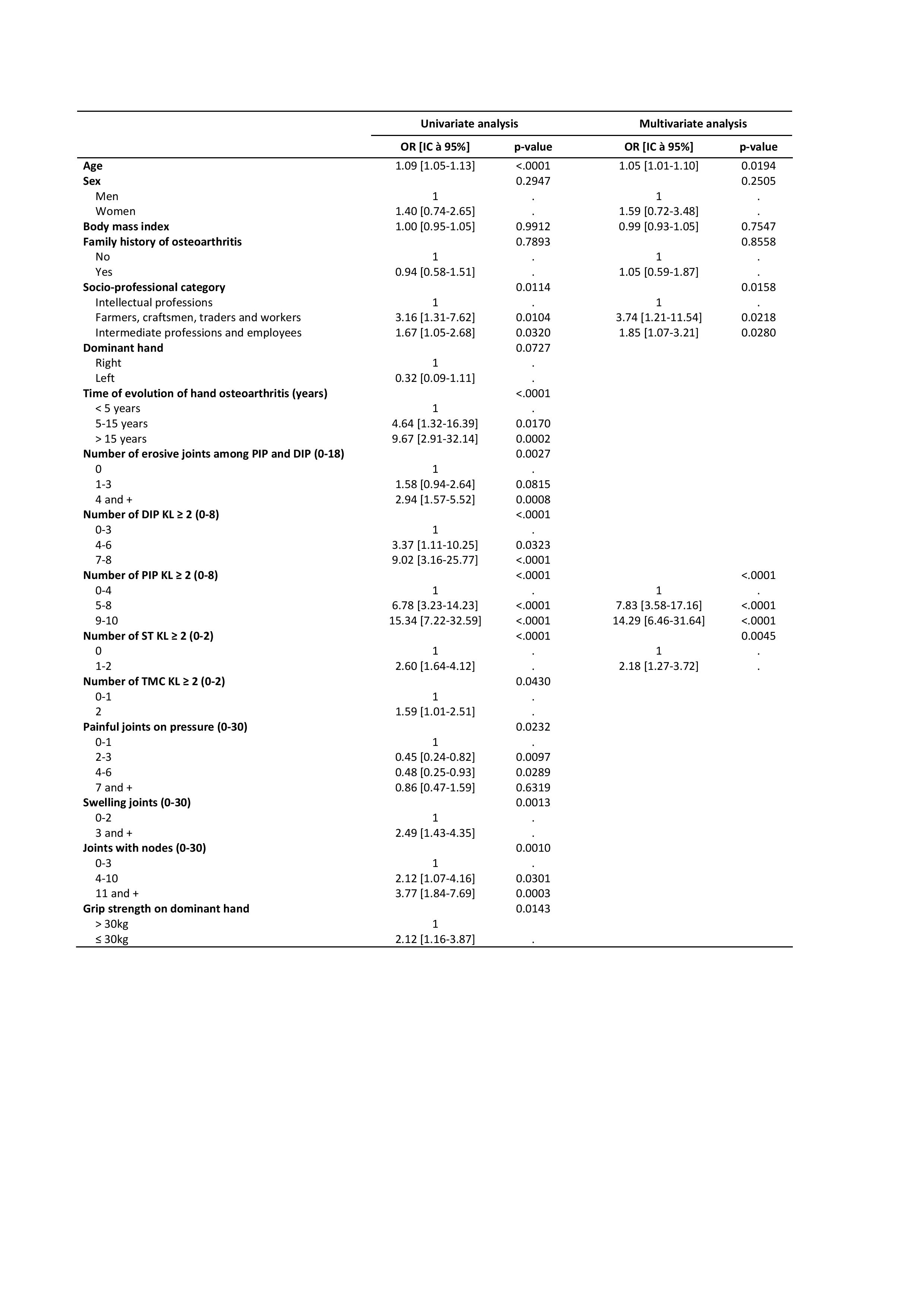Session Information
Session Type: Poster Session C
Session Time: 9:00AM-11:00AM
Background/Purpose: Proximal and distal inter-phalangeal (PIP, DIP) and thumb base joints are the most common sites affected in hand osteoarthritis (HOA), while involvement of metacarpo-phalangeal (MCP) joints is considered as uncommon and rather related to chondrocalcinosis, haemochromatosis or chronic inflammatory arthritis. The aim of this study was to assess the prevalence of radiographic MCP OA in a large cohort of HOA patients and to determine the factors associated with radiographic MCP OA.
Methods: Using the data from DIGital Cohort Osteoarthritis Design (NCT01831570), a French hospital-based observational cohort including patients of >35 years-old with symptomatic HOA, we evaluated the prevalence of radiographic MCP HOA defined by at least two MCP joints with a Kellgren Lawrence (KL) score ≥ 2. This cohort includes patients who have symptomatic HOA according to one of the following definitions: i) symptomatic HOA fulfilling American College of Rheumatology (ACR) criteria on at least 2 joints among proximal or distal interphalangeal (PIP/DIP) joints or first IP joint with KL ³ 2, or ii) symptomatic thumb base OA with KL ³ 2. Patients with chondrocalcinosis or other inflammatory rheumatic diseases (such as psoriatic arthritis or rheumatoid arthritis) were not included. We compared the prevalence of MCP HOA between dominant and non-dominant hands (McNemar test). Associations between radiographic MCP OA and patients characteristics (general and HOA characteristics) were studied using logistic regression. Adjustment was made on age, gender, Body mass index (BMI) and family history of HOA and factors selected in unadjusted analysis (p≤0.20). Odds ratios and their 95% confidence intervals were reported.
Results: 425 patients were included of whom 45.6% had erosive HOA. Radiographic MCP OA was present in 138 patients (32.5%), and 139 (32.8%) patients had at least one painful MCP on pressure. Only two patients (0.5%) had an erosive MCP joint. MCP OA patients had a mean±SD age of 69.2±6.9 years-old, a BMI of 25±4.2kg/m2, 119 patients (86.2%) were women and 89 (66.9%) had a family history of HOA. MCP OA was more frequent at the dominant hand (40.6% vs 34.7%, p=0.01) and predominated at the 1st and 2nd MCP joints.
In multivariate analysis, radiographic MCP OA was associated with older age (OR 1.05; CI95% [1.01-1.10] for each year), manual occupations (OR 3.74, CI95% [1.21-11.54]), the presence of scapho-trapezial OA (OR 2.18, CI95% [1.27-3.72]) and with a higher number of radiographic PIP OA joints (OR 14.29, CI 95% [6.46-31.64]) (Table). No association with obesity or metabolic syndrome (ATPIII criteria), HOA symptoms (pain, stiffness, or function), hyperferritinemia or elevated transferrin saturation coefficient were found.
Conclusion: In this hospital-based HOA cohort, radiographic MCP OA was frequent (32.5%) and associated with structure rather than symptom severity. Our results strongly suggest that the involvement of MCP joints in HOA is predominantly related to mechanical rather than systemic factors.
 Table : Univariate and multivariate analysis. * Systematic adjustment on age, sex, BMI and family history of osteoarthritis
Table : Univariate and multivariate analysis. * Systematic adjustment on age, sex, BMI and family history of osteoarthritis
To cite this abstract in AMA style:
Kouki I, Tuffet S, Crema M, Rousseau A, Richette P, Dougados M, Berenbaum F, Sellam J, Courties A. Metacarpo-phalangeal Osteoarthritis Is Not Rare and Is Associated with Mechanical Rather Than Systemic Factors in Hand Osteoarthritis: An Observational Study from a Large Hospital-based Cohort [abstract]. Arthritis Rheumatol. 2020; 72 (suppl 10). https://acrabstracts.org/abstract/metacarpo-phalangeal-osteoarthritis-is-not-rare-and-is-associated-with-mechanical-rather-than-systemic-factors-in-hand-osteoarthritis-an-observational-study-from-a-large-hospital-based-cohort/. Accessed .« Back to ACR Convergence 2020
ACR Meeting Abstracts - https://acrabstracts.org/abstract/metacarpo-phalangeal-osteoarthritis-is-not-rare-and-is-associated-with-mechanical-rather-than-systemic-factors-in-hand-osteoarthritis-an-observational-study-from-a-large-hospital-based-cohort/
